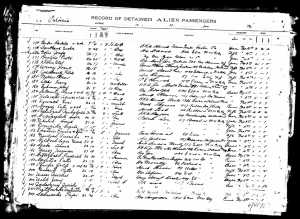One of the things that confused me about the ship manifest for David Goldschlager, before I knew that it was really my grandfather Isadore on the ship using his brother’s name, was that David did not list his brother Isadore as the person meeting him in New York. Instead, he listed an uncle whose name appeared to be Morishe (?) Mintz. I had no idea who this was, and I could not turn up anyone on any document who might have been this mysterious uncle. Also, if Isadore had arrived first, why wasn’t he meeting his brother David?
Once I established that in fact Isadore was the one who had arrived on the Patricia in October, 1904, I went back to look more closely at the manifest and to search again for Uncle M. Mintz, with no luck. I did, however, find a separate document that I had not seen before relating to Isadore’s (“David’s”) arrival at Ellis Island, a Record of Detained Aliens, shown below.
I am familiar with this type of document now because I had seen the one issued for Gisella Goldschlager, who had listed her husband Moritz as the person meeting her. Because her husband had died, she was apparently detained and released to her son Isadore instead. It appears that the same type of occurrence detained my grandfather. On the document it says the cause of detention was “to uncle,” and then in the next column for “Disposition,” it says “Aunt Zusie (?) Mintz, 177 East 111th Street, New York City.” From this I surmised that something prevented Uncle Mintz from meeting Isadore and that instead his wife Zusie had picked him up instead.
That led to a search for the aunt and uncle. I could not find any M Mintz on the 1900 census from Romania who could fit. I searched the NYC marriage index and also had no luck—until I searched for all men named Mintz who had married between 1880 and 1904. I checked every one of them to see what their bride’s names were and was excited when I found a bride named Zusia ROSENSWEIG married to a Harry Minz in 1896. Could this be a third Rosensweig sister?
If so, she would have been the youngest sister, about 14 years younger than Tillie, ten years younger than Ghitla/Gisella. Why would she have left Romania first and not her older sisters? Her sisters did not arrive until 1907 and 1910, respectively, when they were already married and had children. But Zusia was still single, and thus more able to pick up and leave earlier, as did her nephew Isadore at age sixteen.
Harry and Zusia were married in 1896, so I looked again on the 1900 census using the name Harry with a wife with a name that could be Zusia. No luck. I decided to look just for an S or Z Mintz and found a Sonsa Mintz, a widow, living with Jason and Rachel Reitman and their one year old daughter Clara. Sonsa was identified as a cousin of the head of household and as a widow. Assuming that this is the same woman who had married Harry Mintz, it means that her husband died less than four years after they were married. It obviously would explain why he was unable to meet Isadore/David at the boat in 1904. I have not located a death certificate for Harry, however, nor do I know for sure yet that Sonsa is the same person as Zusia or really the sister of Tillie and Gisella.
Unfortunately, I cannot find a Sonsa, Zusia, Susan, or Susie Mintz in any later census. I did find a reference for a Susie Mintz who died in the Bronx in 1931 and is buried in New Jersey, but I do not know if this is the same person. I will order the death certificate to see, but at the moment I have no other records for Sonsa Mintz after 1900. I assume she may have remarried, but I did not find a marriage record either.
The only other possible record relating to the third Rosensweig sister is a ship manifest listing an eighteen year old girl named Sural Rosensweig from Romania, arriving in New York on September 30, 1890. The age and name are close enough that it could be the same person, but I cannot know for sure. (On the 1900 census, Sonsa Rosensweig’s birthdate is April, 1874, and her arrival date is 1891, whereas on the manifest her birth year would have been 1872 and arrival year 1890.)
Although I’ve hit a wall so far with Sonsa and with Harry, her husband, I did look to see if I could figure out how Sonsa was a cousin to the Reitmans. Was it through Harry? Through Jacob or through his wife Rachel? Although I was able to find a number of records for the Reitmans, up through their great-grandchildren, I have not yet figured out the relationship. They, like Sonsa, were from Romania, but beyond that, I have no clues. I have sent an email to one of the great-grandchildren, but it seems quite unlikely that they would know anything about a woman named Sonsa Mintz who lived with their great-grandparents in 1900.
I will have to hope that the 1896 marriage certificate for Harry Mintz and the 1931 death certificate for Susie Mintz have some clues.
[1] With apologies to Wendy Wasserstein. No connection to her play is intended….












